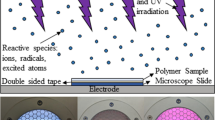Abstract
Different molecular weights of polyethylene glycol (PEG, MW 200, 400, 600, 2000, and 4600) were grafted onto silicon tetrachloride (SiCl4) plasma functionalized polyethylene terephthalate (PET) surfaces. Dramatic increase of the C–O peak in the C1s high-resolution spectra determined by electron spectroscopy for chemical analysis suggests that PEG was successfully grafted. PEG-grafted PET showed significant inhibition of attachment and biofilm formation by Salmonella enterica sv. Typhimurium compared to unmodified PET. The antifouling ability of PEG-grafted PET surfaces was affected by the molecular weight of PEG and PEG2000 was the most effective. Both PEG600- and PEG2000-grafted PET also significantly inhibited biofilm formation by Listeria monocytogenes. Stability tests showed that over 2-month storage under ambient conditions PEG2000-grafted PET demonstrated reduced antifouling ability, but still significantly reduced biofilm formation by S. enterica sv. Typhimurium.







Similar content being viewed by others
References
Gilbert P, Das J, Foley I (1997) Biofilm susceptibility to antimicrobials. Adv Dent Res 11(1):160–167
Fux CA, Stoodley P, Hall-Stoodley L, Costerton JW (2003) Bacterial biofilms: a diagnostic and therapeutic challenge. Expert Rev Anti Infect Ther 1(4):667–683
Mah TF, O’Toole GA (2001) Mechanisms of biofilm resistance to antimicrobial agents. Trends Microbiol 9(1):34–39
Mulhall AB, Chapman RG, Crow RA (1988) Bacteriuria during indwelling urethral catheterization. J Hosp Infect 11(3):253–262
Kehinde EO, Rotimi VO, Al-Hunayan A, Abdul-Halim H, Boland F, Al-Awadi KA (2004) Bacteriology of urinary tract infection associated with indwelling J ureteral stents. J Endourol 18(9):891–896
Den Aantrekker ED, Vernooij WW, Reij MW, Zwietering MH, Beumer RR, van Schothorst M, Boom RM (2003) A biofilm model for flowing systems in the food industry. J Food Prot 66(8):1432–1438
Wong AC (1998) Biofilms in food processing environments. J Dairy Sci 81(10):2765–2770
Zottola EA, Sasahara KC (1994) Microbial biofilms in the food processing industry—should they be a concern? Int J Food Microbiol 23(2):125–148
Harris J (1992) Poly(ethylene glycol) chemistry: biotechnical and biomedical applications. Plenum Press, New York
Sofia SJ, Premnath VV, Merrill EW (1998) Poly(ethylene oxide) grafted to silicon surfaces: grafting density and protein adsorption. Macromolecules 31(15):5059–5070
Du H, Chandaroy P, Hui SW (1997) Grafted poly-(ethylene glycol) on lipid surfaces inhibits protein adsorption and cell adhesion. Biochim Biophys Acta 1326(2):236–248
Zhang F, Kang ET, Neoh KG, Wang P, Tan KL (2001) Surface modification of stainless steel by grafting of poly(ethylene glycol) for reduction in protein adsorption. Biomaterials 22(12):1541–1548
Zhang Q, Wang CR, Babukutty Y, Ohyama T, Kogoma M, Kodama M (2002) Biocompatibility evaluation of ePTFE membrane modified with PEG in atmospheric pressure glow discharge. J Biomed Mater Res 60(3):502–509
Desai NP, Hossainy SFA, Hubbell JA (1992) Surface-immobilized polyethylene oxide for bacterial repellence. Biomaterials 13(7):417–420
Gombotz WR, Guanghui W, Horbett TA, Hoffman AS (1991) Protein adsorption to poly(ethylene oxide) surfaces. J Biomed Mater Res 25(12):1547–1562
Kiss E, Samu J, Toth A, Bertoti I (1996) Novel ways of covalent attachment of poly(ethylene oxide) onto polyethylene: surface modification and characterization by XPS and contact angle measurements. Langmuir 12(6):1651–1657
Alcantar NA, Aydil ES, Israelachvili JN (2000) Polyethylene glycol-coated biocompatible surfaces. J Biomed Mater Res 51(3):343–351
Park KD, Kim YS, Han DK, Kim YH, Lee EHB, Suh H, Choi KS (1998) Bacterial adhesion on PEG modified polyurethane surfaces. Biomaterials 19(7–9):851–859
Dalsin JL, Lin L, Tosatti S, Voros J, Textor M, Messersmith PB (2005) Protein resistance of titanium oxide surfaces modified by biologically inspired mMPEG-DOPA. Langmuir 21(2):640–646
Kingshott P, Thissen H, Griesser HJ (2002) Effects of cloud-point grafting, chain length, and density of PEG layers on competitive adsorption of ocular proteins. Biomaterials 23(9):2043–2056
Szleifer I (1997) Protein adsorption on surfaces with grafted polymers: a theoretical approach. Biophys J 72(2 Pt 1):595–612
Pasche S, Textor M, Meagher L, Spencer ND, Griesser HJ (2005) Relationship between interfacial forces measured by colloid-probe atomic force microscopy and protein resistance of poly(ethylene glycol)-grafted poly(l-lysine) adlayers on niobia surfaces. Langmuir 21(14):6508–6520
Benhabbour SR, Sheardown H, Adronov A (2008) Protein resistance of PEG-functionalized dendronized surfaces: Effect of PEG molecular weight and dendron generation. Macromolecules 41:4817–4823
Zhu B, Eurell T, Gunawan R, Leckband D (2001) Chain-length dependence of the protein and cell resistance of oligo(ethylene glycol)-terminated self-assembled monolayers on gold. J Biomed Mater Res 56(3):406–416
Roosjen A, Kaper HJ, van der Mei HC, Norde W, Busscher HJ (2003) Inhibition of adhesion of yeasts and bacteria by poly(ethylene oxide)-brushes on glass in a parallel plate flow chamber. Microbiology 149:3239–3246
Vacheethasanee K, Marchant RE (2000) Surfactant polymers designed to suppress bacterial (Staphylococcus epidermidis) adhesion on biomaterials. J Biomed Mater Res 50(3):302–312
Roosjen A, van der Mei HC, Busscher HJ, Norde W (2004) Microbial adhesion to poly(ethylene oxide) brushes: influence of polymer chain length and temperature. Langmuir 20(25):10949–10955
Kingshott P, Wei J, Bagge-Ravn D, Gadegaard N, Gram L (2003) Covalent attachment of poly(ethylene glycol) to surfaces, critical for reducing bacterial adhesion. Langmuir 19(17):6912–6921
Cunliffe D, Smart CA, Alexander C, Vulfson EN (1999) Bacterial adhesion at synthetic surfaces. Appl Environ Microbiol 65(11):4995–5002
Dong B, Jiang H, Manolache S, Wong AC, Denes FS (2007) Plasma-mediated grafting of poly(ethylene glycol) on polyamide and polyester surfaces and evaluation of antifouling ability of modified substrates. Langmuir 23(13):7306–7313
Gref R, Luck M, Quellec P, Marchand M, Dellacherie E, Harnisch S, Blunk T, Muller RH (2000) ‘Stealth’ corona-core nanoparticles surface modified by polyethylene glycol (PEG): influences of the corona (PEG chain length and surface density) and of the core composition on phagocytic uptake and plasma protein adsorption. Colloids Surf B 18(3–4):301–313
Acknowledgments
This research was supported by Hatch funds (WIS04771) and by the College of Agricultural and Life Sciences, University of Wisconsin-Madison.
Author information
Authors and Affiliations
Corresponding author
Rights and permissions
About this article
Cite this article
Dong, B., Manolache, S., Wong, A.C.L. et al. Antifouling ability of polyethylene glycol of different molecular weights grafted onto polyester surfaces by cold plasma. Polym. Bull. 66, 517–528 (2011). https://doi.org/10.1007/s00289-010-0358-y
Received:
Accepted:
Published:
Issue Date:
DOI: https://doi.org/10.1007/s00289-010-0358-y




